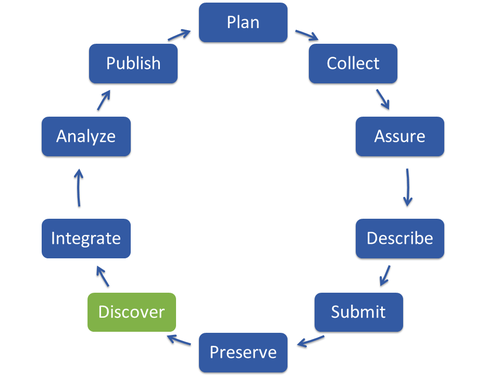Discover
What is it?
In the discovery stage you search for available data that might be valuable and usable for your own study or research project. To discover data and their metadata, they need to be visible and accessible. This means data have been submitted (see Fact-Sheet ‘Submit’) to a data infrastructure (archive, data center) and they ideally have a persistent identifier (PID).

How to do it?
- Be aware that the terms/key words you use for your search will influence the data discovery. The GFBio semantic search supports faceted search and integrates specialist ontologies which make your query more efficient.
- Discover available and suitable data sets for developing new research questions, for testing or comparing them with your own data by using e.g. geographical overlays.
- To gain access to the data you are interested in, gather information about the rights and access management that might allow access to only authorized users.
- To fulfil authentication requirements, you might need to register or get into contact with the data owner
- When data are linked to journal publications you might gain access via the journal homepage or be redirected to the data center.
Who does it?
Data re-users in general, e.g. modelers, researchers conducting integrative or comparative studies.
Key Elements
- Use appropriate key terms.
- Discover the suitability of a data set through associated visualization and analysis tools and read the metadata.
- Check the access requirements and authentication procedures.
GFBio Services
Data Search
- GFBio Search: offering a single access point for a faceted search and filtering of data sets stored in the associated, interoperable, long-term data centers and archives.
Search for acronyms and synonyms, provided by our Terminology Service.
Save your search results in a basket and download data you are interested in.
Data Visualization and Analysis
- GFBio VAT System for Visualization-, Analysis- and Transformation of retrieved data (e.g. compare them with your own data using graphical overlays)
Useful Links
http://www.lifewatch.eu/web/guest/home (European infrastructure for biodiversity data)
http://www.gbif.org (International open data infrastructure for biodiversity data)
http://www.pangaea.de (Data publisher for earth and environmental science)
http://www.unidata.ucar.edu/software/thredds/current/tds (Thredds Data Server)
http://mercury.ornl.gov (Metadata-Search and associated data)
Recommended citation:
German Federation for Biological Data (2021). GFBio Training Materials: Data Life Cycle Fact-Sheet: Data Life Cycle: Discover. Retrieved 16 Dec 2021 from https://www.gfbio.org/training/materials/data-lifecycle/discover.